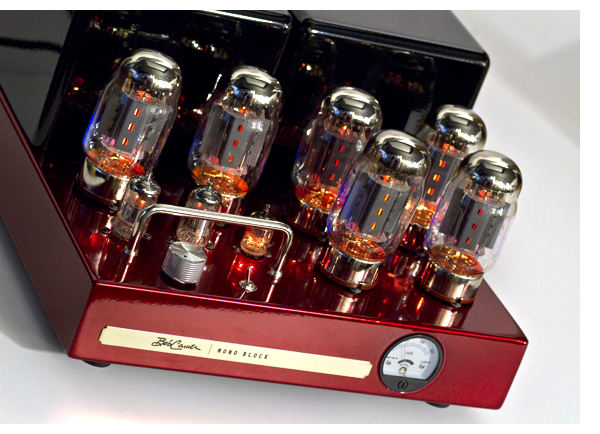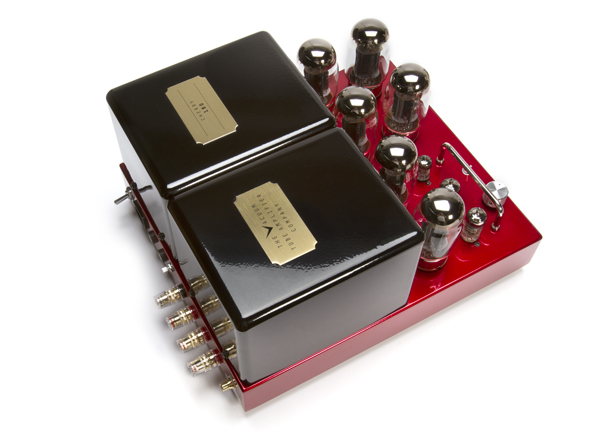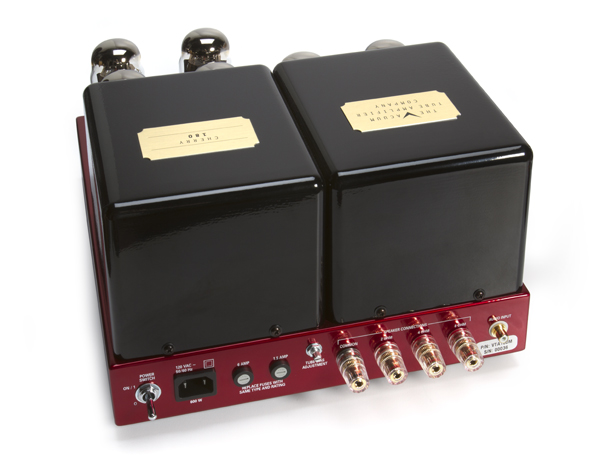Carver VTA180M Tube Monoblocks American Muscle, With Finesse
 Throughout his career, Bob Carver has made several legendary products and, like most great artists, stirred up controversy in the process. His new line of tube amplifiers aren’t just brilliant, they’re reasonably priced. For those wanting the “Made in America” badge, these crimson beauties—along with every other Carver amplifier—are built by hand in Lexington, using point-to-point wiring techniques.
Throughout his career, Bob Carver has made several legendary products and, like most great artists, stirred up controversy in the process. His new line of tube amplifiers aren’t just brilliant, they’re reasonably priced. For those wanting the “Made in America” badge, these crimson beauties—along with every other Carver amplifier—are built by hand in Lexington, using point-to-point wiring techniques.
The VTA180M features a simple and honest design. Its basic, open chassis configuration adds to the vintage feel and keeps costs manageable. You won’t mistake these units for a pair of megabuck tube amps machined from solid billets of aluminum. Well, not until you turn them on. Then, be prepared to be pleasantly surprised.
Having sampled many great tube amplifiers over the last few years, I was immediately impressed by the VTA180M’s level of detail and grunt provided by the 200 watts-per-channel reserve. Vide, Bombay Dub Orchestra’s 3 Cities. This record serves up big, synth-bass beats that challenge any amplifier driving full-range speakers. The Carvers reward my GamuT S9s (that have a -3db point of 17hz) with solid, texture-laden bass and subterranean extension.
They also require little warm-up time. With just a half hour on the clock, the amps piqued my interest when playing Chemical Brothers’ “Galvanize” from Push The Button. The assault of bombastic bass waves encouraged me to twist the volume control to nightclub-like levels. As the GamuT S9s’ six 11.5-inch woofers pumped, I felt like the guy in the Maxell chair, with the system moving major air sans strain or distortion. The amps sound enticing even after the first five minutes, but require 45 minutes to thermally stabilize and reach full bloom. Once there, an enormous, three-dimensional soundfield awaits. Vacuum-tube newbies will experience an entirely different sonic landscape.
Midrange Options
Reach-out-and-touch-it midrange is almost always a given with tube amps; the extra airiness draws music lovers to vacuum tubes. The VTA180M lets you pick a preferred presentation, offering two feedback settings: 11db (contemporary amplifier) and 20db (classic amplifier) that affect the upper bass/midrange presentation. According to the concise instruction manual, Carver leans toward the classic setting, and it’s nice to have the option. Plus, you can switch the setting on the fly without suffering any annoying or potentially harmful pops.
The extra feedback provides a warmer, more saturated sound, much like many beloved vintage tube amplifiers. Meanwhile, the 11db setting possesses a punchier sound and tighter bass response. It’s also great for fine-tuning an amplifier to speakers. So, even if your taste in speakers changes, your amplifier can remain in the system. This is a great way of making the VTA180Ms obsolete-proof. One note: Should you have a pair of speakers that already have a bump in the upper-bass/lower-midrange region, a romantic-sounding tube amplifier can be too much.
In addition, you can use the feedback switch as a tone control. Regardless of your system’s overall tonal balance, if you listen to a fair amount of MP3s via MOG, Spotify, or another online service, extra tonal warmth supplied by the VTA180M in the classic amplifier mode goes a long way towards making harsh digital sources more listenable.
For Those About to Roll
Tube rolling with the VTA180M is effortless. Its open casework allows easy access. The stock tubes sound awfully good, so your degree of OCD will determine whether they constitute the equivalent of a quick jaunt down the bunny hill or a Double Black Diamond run. Should you swap them out, you will need a dozen power tubes—not for the faint of checkbook. A set of Gold Lion reissued KT-88s imparts a less grainy feel, and sacrifices nothing in the top and bottom ends of the frequency spectrum. Just be sure to check the front-panel bias meter and adjust accordingly when fitting a different set of output tubes. Again, the Carver manual goes into great detail explaining the process and makes it all simple.
Experimenting with the 12AX7 input and the 12AT7 pre-driver tubes offers a wider range of tonal change than fiddling with the output tubes. With only one of each tube per monoblock, it’s a basic exercise. While NOS 12AX7s can soar as high as $300 each (for super high-zoot Mullards and Telefunkens), Mullard 12AT7s rarely top $30. The 12AX7 is the tonemeister: Changing it affects overall tonality as much if not more than the feedback switch. Or, you can just leave the VTA180M stock and enjoy as is. Or can you? Decisions aside, Carver offers an impressive one-year warranty on the factory tube set and seven-year warranty on the amplifier.
 The Whole Enchilada
The Whole Enchilada
Tube amplifiers live and die on the top and bottom of the audio spectrum. Some offer a dreamy, creamy, albeit slightly rounded off high-frequency response, a trait especially attractive to digital music collections. Other units put forward a very refined, extended, clinical sound that gets so close to the character of solid-state gear, one ponders why valves were ever chosen.
The VTA180Ms provide excellent overall tonal balance, regardless of feedback setting. Low-end extension is particularly healthy. Tube amplifiers rarely possess great bass texture, yet the VTA180M excels in this region. Tom Petersson’s bass on Cheap Trick’s self-titled album enjoys alluring growl. The opening bass riff on “Mandocello” bites and feels natural. As his hand slides up the instrument’s neck, it sounds like you’re standing in the front row of a small venue peering right at a big Ampeg bass cabinet. A similar experience occurs with an early British pressing of the Beatles’ Revolver. Even at high volume, Paul McCartney’s bass line stays solid and easy to follow, with plenty of definition.
Things are equally good up top. Without surrendering any tonal saturation, the VTA180M provides a clean, resolute high end. Cymbals are portrayed with plenty of air and texture, feeling neither rolled off nor exaggerated. Switching back to a few vintage amplifiers on hand from Dynaco and Marantz reveals similar tonal saturation, but to the point of obvious coloration and grain, particularly when listening to Joe Sample and Co. on The Three, an incredibly well-recorded direct-to-disc LP. Shelly Manne’s drumming loses the air present via the Carver, through which the percussion sounds like real cymbals.
When spinning Revolver, the background handclaps in “And Your Bird Can Sing” are not as prominent as it is with the best amplifiers at my disposal. This slight loss of ultimate low-level resolution, in comparison to that delivered by big-dollar gear, is the VTA180M’s only apparent weakness. But these cherry-red monoblocks do everything else so well, you won’t notice it.
The VTA180Ms feature a single-ended RCA input and work flawlessly with the handful of on-hand preamplifiers from Audio Research, Conrad Johnson, Burmester, McIntosh, and the new Coffman Labs model currently under review. Thanks to 2-, 4- and 8-ohm output taps, the Carvers show no problem driving the MartinLogan Montis speakers and even produce enough juice to drive the Magnepan 1.7s to fairly high levels. If you are nervous that the rated 230 watts-per-channel isn’t enough for your Magnepans, Carver’s VTA305M monoblocks should get you there.
 Award Winning Performance
Award Winning Performance
I am very excited about the VTA180M amplifiers. Designed by a legend, they offer a no-nonsense approach, with money spent in the right places. We could talk in circles about parts and topology choices, sure. But in the end, these amplifiers do everything well, volunteering a sensory experience that normally commands a higher price.
Indeed, this is a tube lover’s pair of amplifiers. They provide more than enough power to drive all but the most inefficient speakers, and boast an extraordinary level of refinement. The ability to drive low-impedance loads, as well as the option to change feedback and alter the amps’ character to suit personal tastes, are bonuses.
If there’s a better pair of 200-watt-per-channel tube amplifiers out there for this kind of money, I haven’t heard them yet. The Carver VTA180M monobocks richly deserve an Exceptional Value Award for 2012.
Carver VTA180M Monoblock Power Amplifiers
MSRP: $7,400/pair
www.bobcarver.com
Peripherals
Analog Source AVID Acutus Reference SP/TriPlanar/Lyra Atlas
Digital Source dCS Paganini 4-box stack, Sooloos Control 15
Phonostage Audio Research REF Phono 2SE
Speakers GamuT S9
Cable Cardas Clear
Accessories Furutech DeMag, DeStat, Audio Desk Systeme RCM



